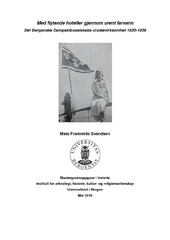| dc.description.abstract | The interwar period is largely regarded as period of negative trends, both in terms of international politics, economic and social issues. However, both tourism and pleasure cruising thrived in the 1920s and 1930s, and became an important source of income for many shipping companies. In this master thesis I seek to examine how The Bergen Steamship Company (BDS) developed a very specialised type of cruising in the period 1920-1939. The key questions in this thesis is how and why BDS engaged in cruising and tourism in the 1920's and 1930's. I argue that cruising in one sense was an important part of a diversification-strategy, and reflected a greater focus on tourism. Cruise also became an important part of the company's identity and brand. Since the late 19th century, BDS had developed into one of Norway's largest shipping companies, particularly in the passenger business. In addition to several passenger-, mail- and cargo services along the coast of Norway, and to large European ports such as Rotterdam and Hamburg, the service between Bergen and Newcastle upon Tyne in the UK was the company's most important and most profitable. The latter service also became a very important tourist route for both British and American tourists to Norway. Unlike other shipping companies in the interwar period, BDS operated two small, but very specialised and luxurious cruise ships named S/Y Meteor and M/Y Stella Polaris . The latter became very important as a symbol for the company. During the whole period BDS spent very large financial resources , regarding new ships, refurbishing and rebuilding of the ships, but also in developing sales- and marketing departments in both the UK and the United States. In order to attract passengers and to operate efficiently and economically in a cruise-market, BDS had to establish a large network of agents. More than any other trade or business, the engagement in cruise made BDS into an international player. Despite being a marginal international player with little international experience, BDS showed considerable will and ability to adapt to market changes | en_US |
